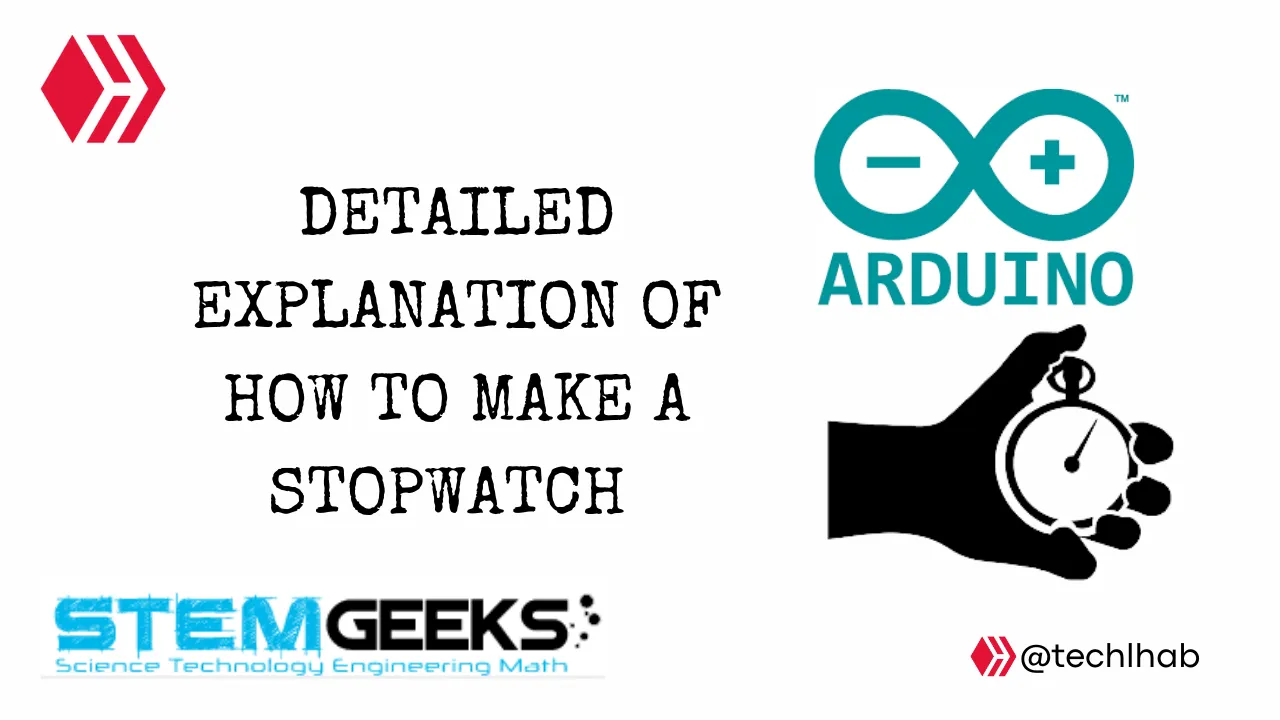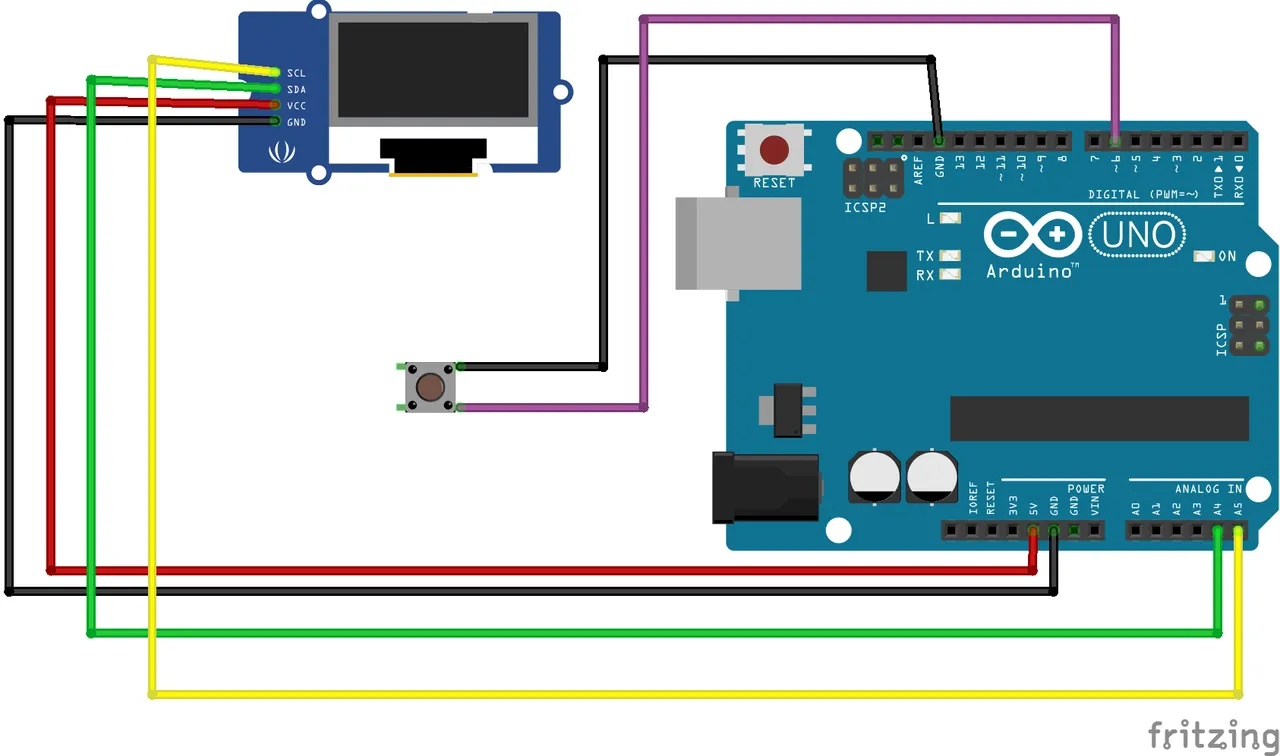As it is known that the stopwatch occurs to be a very important device we most of the time use in our daily lives in measuring the time interval of an event. It is highly utilized and stands out due to its high accuracy and precision in which it measures time intervals by the press to a start and stops button. I'm @techlhab and today I would be sharing with us how to make is DIY Smart Stopwatch using an Arduino Uno microcontroller, Push Button, and OLED Display Screen as the major hardware components. While the software components are; the Arduino IDE, Embedded C/C++ programming language, and fritzing for circuit design and simulation.

- Arduino Uno
- OLED Display Screen
- Push Button
- Arduino IDE (Integrated Development Environment)
- Embedded C/C++
- Fritzing
The Arduino Uno is a popular open-source microcontroller that uses the ATMEGA328P PIC (Programmable Integrated Circuit) chip developed by Arduino.cc. It has 14 digital I/O (Input / Output) pins and 6 analog I/O pins.
In this project, that is the stopwatch, the Arduino Uno microcontroller serves as the brain of the device, with which other components connected to it sends and receives instructions to and from respectively based on the code or instructions programmed to the microcontroller.

The OLED is a four (4) terminal display screen which helps in displaying relevant information to the users for interactions. And It is used here to serve a major purpose of displaying the stopwatch time as it counts.
It also has 4 pins which are:
- Vcc
- Gnd
- SDA
- SCL

- Conneting the Push Button to the Arduino Uno
| Arduino Uno | Push Button | |
|---|---|---|
| 1 | S | D6 |
| 2 | Gnd | Gnd |
- Conneting the OLED Display Screen to the Arduino Uno
| Arduino Uno | OLED Display Screen | |
|---|---|---|
| 1 | 5v | Vcc |
| 2 | Gnd | Gnd |
| 3 | A4 | SDA |
| 4 | A5 | SCL |


// Arduino OLED Stopwatch
#include
#include
#include
#include
#include <Fonts/FreeSans9pt7b.h>
#include <Fonts/FreeSans18pt7b.h>
#include <Fonts/FreeSans12pt7b.h>
#define SCREEN_WIDTH 128 // OLED display width, in pixels
#define SCREEN_HEIGHT 64 // OLED display height, in pixels
// SCL A5
// SDA A4
#define OLED_RESET 0 // GPIO0
Adafruit_SSD1306 display(SCREEN_WIDTH, SCREEN_HEIGHT, &Wire, OLED_RESET);
#define LOGO_HEIGHT 16
#define LOGO_WIDTH 16
const unsigned char PROGMEM icon [] = {
0x00, 0x1F, 0xF8, 0x00, 0x00, 0x1F, 0xF8, 0x00, 0x00, 0x1F, 0xF8, 0x00, 0x00, 0x1F, 0xF8, 0x00,
0x00, 0x1F, 0xF8, 0x00, 0x00, 0x03, 0xC0, 0x00, 0x00, 0x00, 0x00, 0x40, 0x00, 0x00, 0x00, 0xE0,
0x00, 0x1F, 0xF8, 0xF0, 0x00, 0x7F, 0xFE, 0x70, 0x00, 0xFF, 0xFF, 0x20, 0x01, 0xF0, 0x0F, 0x80,
0x03, 0xC1, 0x83, 0xC0, 0x03, 0x81, 0x81, 0xC0, 0x07, 0x01, 0x80, 0xE0, 0x07, 0x01, 0x80, 0xE0,
0x0E, 0x01, 0x80, 0x70, 0x0E, 0x01, 0x80, 0x70, 0x0E, 0x03, 0xC0, 0x70, 0x0E, 0x03, 0xC0, 0x70,
0x0E, 0x03, 0xC0, 0x70, 0x0E, 0x01, 0x80, 0x70, 0x0E, 0x00, 0x00, 0x70, 0x07, 0x00, 0x00, 0xE0,
0x07, 0x00, 0x00, 0xE0, 0x07, 0x80, 0x01, 0xE0, 0x03, 0xC0, 0x03, 0xC0, 0x01, 0xE0, 0x07, 0x80,
0x00, 0xF8, 0x1F, 0x00, 0x00, 0x7F, 0xFE, 0x00, 0x00, 0x1F, 0xF8, 0x00, 0x00, 0x07, 0xE0, 0x00
};
const unsigned char PROGMEM swatch [] = {
0x03, 0xC0, 0x03, 0xC0, 0x03, 0xC0, 0x00, 0x08, 0x07, 0xEC, 0x0E, 0x70, 0x18, 0x18, 0x30, 0x0C,
0x30, 0x8C, 0x21, 0x84, 0x21, 0x84, 0x30, 0x0C, 0x10, 0x08, 0x18, 0x18, 0x0F, 0xF0, 0x03, 0xC0
};
void setup() {
pinMode(6,INPUT_PULLUP); //Switch
display.begin(SSD1306_SWITCHCAPVCC, 0x3C); // initialize with the I2C addr 0x3C (for the 64x48)
display.display();
display.clearDisplay();
display.setFont(&FreeSans9pt7b);
display.drawPixel(10, 10, SSD1306_WHITE);
display.setTextColor(WHITE);
display.setCursor(0,0);
display.print("Viral Science");
display.display();
delay(800);
}
int poz=1;
int broj=1;
int kretanjeY=30;
int sec1=0;
int min1=0;
unsigned long msec=0;
unsigned long mili=0;
int pres=0;
int fase=0;
int start=0;
unsigned long tim=0;
void loop()
{
display.clearDisplay();
if(digitalRead(6)==0)
{
if(pres==0)
{
fase=fase+1;
pres=1;
if(fase>2)
fase=0;
}
}else{pres=0;}
if(fase==0)
{
display.setFont(&FreeSans12pt7b);
display.setFont();
display.setCursor(50,50);
display.print("Start");
display.drawBitmap(48, 8, icon, 32, 32, WHITE);
sec1=0;
min1=0;
tim=0;
mili=0;
msec=0;
start=0;
}
if(fase==1)
{
display.clearDisplay();
display.setFont(&FreeSans12pt7b);
display.setFont();
display.setCursor(37,0);
display.print("Stopwatch");
display.setFont(&FreeSans9pt7b);
if(start==0)
{
start=1;
tim=millis();
}
msec=(millis()-tim);
min1=msec/60000;
if((msec/1000)>59)
{
sec1=(msec/1000)-(min1*60);
}else{
sec1=msec/1000;
}
mili=(msec%1000)/10;
display.setCursor(42,30);
if(min1<=9)
{
display.print("0");
display.print(min1);
}else {display.print(min1);}
display.print(":");
if(sec1<=9)
{
display.print("0");
display.print(sec1);
}else {display.print(sec1);}
display.setFont(&FreeSans12pt7b);
display.setCursor(50,57);
if(mili<=9)
{
display.print("0");
display.print(mili);
}else {display.print(mili);}
}
if(fase==2)
{
display.clearDisplay();
display.setFont(&FreeSans12pt7b);
display.setFont();
display.setCursor(52,0);
display.print("Time:");
display.setFont(&FreeSans9pt7b);
display.setCursor(42,30);
if(min1<=9)
{
display.print("0");
display.print(min1);
}else {display.print(min1);}
display.print(":");
if(sec1<=9)
{
display.print("0");
display.print(sec1);
}else {display.print(sec1);}
display.setFont(&FreeSans12pt7b);
display.setCursor(50,57);
if(mili<=9)
{
display.print("0");
display.print(mili);
}else {display.print(mili);}
display.drawBitmap(105, 20, swatch, 16, 16, 1);
display.drawBitmap(12, 20, swatch, 16, 16, 1);
}
display.display();
}
Thanks for reading and visiting my blog 🤝. Kindly support this post by reblogging, upvoting, and commenting, it would be highly appreciated.
Images used in this post were all designed by me using frizting, a circuit design and simulation software, and canva.
